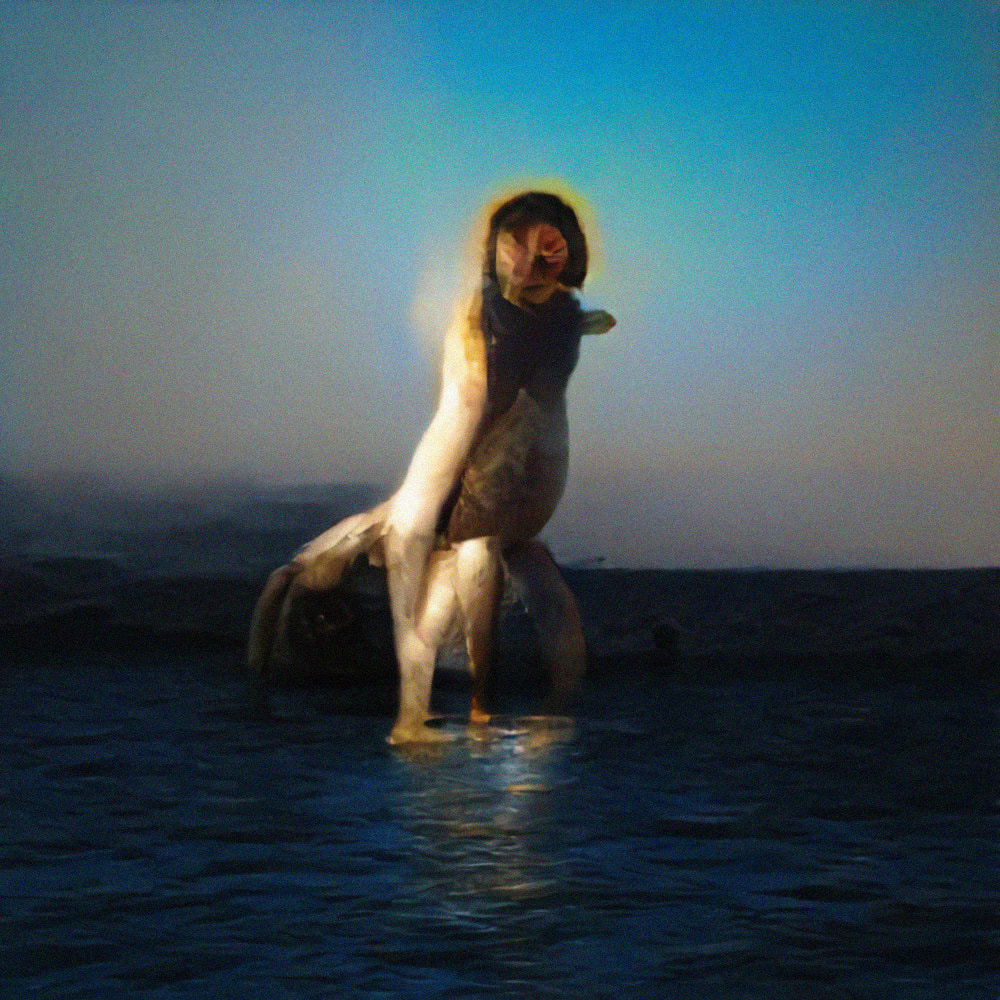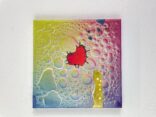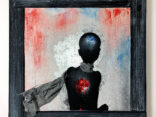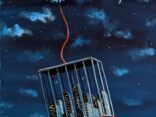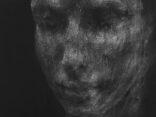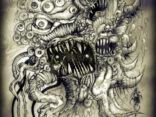Autore
Indice
- Copying and altering life as a creative process
- The circuits of man and the circuits of life
- A higher level of creation
- Conclusions
↓ download pdf
S&F_n. 26_2021
Abstract
Creativity by coping: imitating life as a work of imagination
Engineering biological systems is easily interpretable as a process of mere and cold replication, or even distortion, of the natural domain, since it is often linked to industry and built on the Cartesian assumption of human rationality’s control over a submissive nature. In this article, I approach living systems design from an alternative perspective, supporting its similarities with activities which are traditionally associated with creativity, like arts. I show that different kinds of creativity are deeply involved in copying, composing, and modifying life, focusing on two different levels: that of scientific modelling, recognisable by looking at biological circuits design, and that of actual building of new organisms of evolutionary interest, like the artificial bacterium JCVI-syn3.0.
- Copying and altering life as a creative process
According to the Plato of the Republic, imagination has no role at all in arts: the painter always depicts, blindly applying rules he learned in past, what he is perceiving or remembers having perceived. Leonardo da Vinci, who had a similar view, added that accurate study and representation of nature by an artist inevitably turns the latter into a scientist. Again, according to this perspective, the scientist is just a mirror too, exactly like the artist. This is a quite primitive idea of imitation, seen as a passive and automated procedure. Indeed, no predefined rule is so detailed as to eliminate the active contribution, vision and skill of an artist or a scientist[1].
In modern science, synthetic biology and its systemic foundations are undoubtedly among the fields which most deeply involve a process of imitation of nature: scientists are nowadays able to replicate, modify, and create (both virtually or concretely) biological systems through engineering methods, with the aim of producing or testing something useful in a wide variety of areas, like valuable chemicals and drugs[2]. Certainly, both imagination and creativity (which relies on the former) are always needed in engineering, since it is based on visualizing and realizing possible solutions to real-world challenges. However, I want to highlight other non-obvious reasons why this emergent horizon of biology is a matter of imagination and, more specifically, why synthetic biologists can be authors of authentical novelties. One of these reasons is a special case of what is found in all science, and concerns modelling. The second one is more peculiar to synthetic biology and its technological essence and has to do with the imaginative potential associated with the creation of alternative life forms.
Before arguing about all this, I want to make a short moral premise. As any other new frontier of science and technology, engineering life and recreating organisms can give rise to some disputes (e.g., the “Playing God argument”): to what extent manipulation of nature by scientists can be morally acceptable? Are there precise limits which must be considered? Although such criticisms should not be carelessness dismissed, it can be argued that biological systems design may be seen as a sort of a celebration of the “sacred” side of nature, since biologists conceive and build these systems with their natural capacity to imitate other life forms and generate innovations. There is no subversion of the order of things. Artificiality is nothing more than human’s niche construction, the spontaneous tendency to build our own environment. Thus, there are not abstract boundaries or acts of arrogance towards life. As it is usually said, it is all about the possible issues linked to uses and effects of what is produced. However, the obvious distortions (e.g., possible military applications) from which almost no scientific area is, unfortunately, immune, will not be considered in this article.
- The circuits of man and the circuits of life
A recent work concerning the lack of promotion of creativity in science (but not in arts) by institutions, has inevitably recalled the prominent position of this human attitude in both activities[3]. Since systems and synthetic biology results are usually more like inventions than like discoveries, they lie in a middle ground between scientific theory and technological craftsmanship, so we may expect they would encompass both types of creativity. However, these areas of expertise have some constraints: they are always based on copying biological systems. If it is so, how can these replicative efforts be called “creative”?
This is an apparent limit. Replicating bio-systems, as any other form of technology, does not imply that human creativity is always limited by the existent, contrary to the old conservative interpretations of Aristotle's notion of «technology imitating nature»[4]. As a matter of fact, nothing is new: innovations may derive from combinations or extensions of pre-existing elements or ideas[5]. In these biological fields, the fundamental creativity which is typical of all scientific modelling is enhanced by engineering: this means that models representing existing things and projects of possible creations are related. However, at the most basic level, the choice of how to reproduce a system, among many possibilities, and the subsequent uses of the resulting model, can be seen as the first symptoms of creativity. The following example shows these operations, adopting a minimalist approach to reproduce bio-systems.
Although formal logic is the most abstract form of human thought, it can still be used to imitate some biological parts in an elegant way. Here, it may be seen as a possible counterpart of what the study of perspective is in painting: a representative technique based on sound rules. Logic circuits are more and more used both for virtual simulations and to concretely reproduce organisms’ subsystems in a consistent way. In the most general sense, a digital circuit is a component designed to treat binary information[6], like the two possible variables of Boolean algebra, which can be transmitted as signals: 1 and 0. The fundamental elements of circuits are called logic gates, since they are functionally associated with logical operations or logical connectives such as negations, conjunctions, and disjunctions. The basic function of a logic gate is to receive a certain number of binary input signals, and then to produce a particular output signal, depending on the logical characteristics of that specific gate (e.g., an AND gate will produce output 1 only if all its inputs are 1, and output 0 in all other cases, like a conjunction: to be true, all its parts must be true together). In turn, each output may be an input for another gate, and so on.
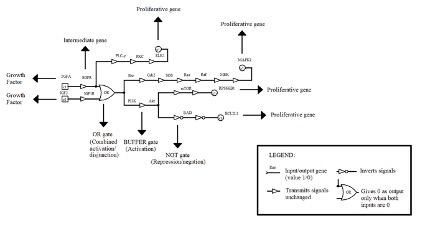
Figure 1. A plausible example of a biological circuit consistent with the molecular processes leading to liver cancer.
It was developed with the software Logisim[7] and it has a purely illustrative value. It is based on the information on Hepatocellular carcinoma contained in KEGG (Kyoto Encyclopedia of Genes and Genomes) database, which allows users to consult graphical representations of many interactions among biological entities[8]. There is a starting point, which is represented by two growth factors within the squares in the far left, four genes involved in cell proliferation at the end of each wire, and a lot of intermediate genes through which a binary signal propagates from the start to the end of the circuit. A value of 1 implicates an expressed gene, and a value of 0 an unexpressed one. The initial values of the growth factors are decided, for each simulation, by researchers. The more proliferative genes are activated, the more the final output will be negative (cancer), and vice versa[9].
Talking about biological circuits means implicitly accepting the metaphor which connects a cell to a Turing machine: one may think gene expression in terms of molecular inputs which can activate a regulatory program that enhances or inhibits the transcription of a DNA segment[10]. In this sense, we can say that cells regularly use their own genetic “circuits” to adapt their behaviour in response to environmental stimuli. Indeed, it would certainly be harmful if all genes of a bacterium were constitutively (i.e., always) expressed. The metaphor holds good because gene expression or non-expression may be approximately attributed to a binary condition (1/0). Then, in human imagination, a cell may be thought as a device that can be turned on or off with a switch. Once the (human) circuit is implemented, it can be manipulated in any point, to obtain an observable effect on the final output of the whole system. These hypothetical explorations are extremely valuable for virtual clinical trials, allowing scientists to test the influence of mutations, drugs, or other molecules. Obviously, a more detailed exposition of the topic is beyond the scope of this article, but the related literature is abundant[11].
This technical excursion contains some remarkable suggestions for an investigation on the creativity behind life copying. Most importantly, biological circuits are plastic examples of how, at a basic level, life may be represented and recreated by minimal human thought. The poetry of living systems, although it may sometimes appear obscure and inextricable, in such models is anything but the high-level result of a composition of “monosyllables”: binary inputs, once combined, can generate significant final outputs in the behaviour of an imagined cell, and this is approximately correspondent to what happens inside real cells.
However, it does not imply a simple “copy-and-paste” process. It is more like a translation. Recent theories on rewriting practices have highlighted the existence of a «fuzzy space»[12] between rigorous translation and imaginative writing, a continuum ranging from high fidelity to high freedom. The original text, with the active contribution of the translator, can be potentially transformed into a new creation during the process. In the case of biological circuits, imaginative effort and transformative potential lie in the discrepancy between living reality and virtual models, life and logic, and in the simplification required to adequate these two worlds. Therefore, creativity is embedded in the process of modelling itself. With a set of basic rules and the capacity to capture analogies between biological interactions and human reasoning, researchers can transfer the relevant properties of cells in a completely new format, creating a new system and altering it as they need or wish.
Nevertheless, there is more than “faithful” circuit representations and point-like alterations of virtual systems. Indeed, recent applications of logic circuits on cancer pathways, despite their huge importance in the field of clinical testing, are just a small part of a whole range of possibilities.
- A higher level of creation
Is this “just” imitation of nature by artificial means? In the previous paragraph, I tried to show that the right answer to such a question is certainly “not at all”. In the same way that every art is based on knowledge of specific media and tools (e.g., musical instruments), prior knowledge on the relationships among biological entities and on tools such as Boolean logic are just prerequisites for the subsequent creative moment. Furthermore, synthetic biology is more about redesigning life than modelling existing systems.
Indeed, the creative endeavour is way deeper when considering the recent projects of realization of new and different organisms from scratch. This is astonishingly evocative for evolutionary biology: in this field, scientists are increasingly convinced on the necessity to complement their retrospective investigation on the history of life with novel approaches, like the “constructive” one. Their ultimate goal, when approaching synthetic biology, is that of imitating nature to go beyond (known) nature itself. As pointed out by one of the most important biologists of the second half of 20th century, John Maynard Smith, we cannot limit ourselves studying only our evolving system (i.e., the terrestrial biosphere). Indeed, to do some generalizations, we need to focus on alternative evolutionary systems, which must be artificial ones[13], since we do not have the possibility to rewind the film of life on Earth or to observe life on other planets. Although engineered organisms are based on information from this biosphere, they currently are much more than trivial replicas of the existent.
No replica alone may suggest, or even represent itself, a possible starting point for evolutionary paths which substantially differ from those studied by biologists and determined “by nature” (even if humans are nature’s parts, and they have already modified species in innovative ways since the first episodes of artificial selection). Life, intended as a general natural phenomenon, is not a unique story or a universal loop, but a generative seed capable of giving birth to plenty of different lines, and new engineering methods allow to produce material examples of other lives or bio-systems. It would not be wrong to think about the new evolutionary-synthetic research as a more planned counterpart of Stanley Miller's “constructive” experiment on the self-assembly of amino acids[14], a real cornerstone of history of biology. Again, what I would like to emphasize most is the creative contribution and the subsequent visionary potential of this approach. To do this, I will mention a specific case from recent research.
The artificial JCVI-syn3.0[15] is a good exponent of evolutionary usefulness of synthetic biology. After several cycles of designing, building, and testing, the objective of realizing a completely artificial organism with a minimal genome (i.e., only with genes required for viability and growth) was achieved. This stunning, microbic chimera, was born from molecular data on already existing bacteria, but it can also be considered a human invention, which cannot be found anywhere in nature. It is, from all points of view, a work of imagination. A work which was surely inspired by replicas but which, at the same time, deeply differs from a “simple” replica. And, like any other good creative product, it can be a catalyst for thought: the existence and availability of such an artificial life form may suggest new and interesting perspectives on the beginning of cell life, allowing our minds to travel both back in time and in other worlds, where life was, or still is, in its infancy. So, synthetic organisms with minimal genomes not only shed new light on the first precursor of cells on Earth, LUCA (Last Universal Common Ancestor), but open countless possibilities, stimulating creativity through other creativity.
Building on results of such magnitude, the hypothetical “synthetic domain” is sometimes reported, in an exaggerated or provocative way, as the fourth domain of life, alongside the three which have already been classified (i.e., bacteria, archaea, and eucaryotes). The idea of a rational plan behind a whole branch of the tree of life is incompatible with Darwinian evolution, but the metaphor may be interpreted in an intriguing way. Indeed, it strongly emphasizes the element of potentiality. Synthetic biologists’ work may be compared to that of the OULIPO poets: if playing with the rules of human language can lead to the creation of unprecedented texts, playing with the rules of genetic language unlocks the passage for the building of unprecedented life[16].
I would like to go further and venture another literary comparison, also supported by the existence of the Playing God argument: can synthetic biology be thought as a «divine game»[17], as Russian writer Vladimir Nabokov once defined a work of art? One half of the reference («divine») is literally applicable to this field, because nothing like creating life artificially brings man nearer to the action of a “divinity”. The second half can also be applied to our case, but in a different way than that imagined by Nakobov (i.e., game as a complete fiction): engineering life is a game because it has strict rules that must be considered to reach some results (e.g., the genetic code rules).
Furthermore, as in the case of fictional works like novels, the value of artificial organisms like the one mentioned above can be guessed also by those who cannot fully understand all the details of their composition. In other words, they are accessible and evocative also looking at them superficially, like hard science fiction works. At this point, the boundaries between artistic and scientific creativity seem to fade to the point of becoming indistinguishable.
- Conclusions
Biologists are now able to reproduce the functioning of life at its most fundamental levels, connecting simple parts and behaviours to learn through imitation, then to create through learning. Synthetic biology is the next, natural step of computational and systemic thought applied to life sciences, and it closely recalls the aim of all arts: researchers, with the use of some specific techniques, actively copy nature and then change it to generate new variations on a theme. The most striking difference with “classic” art, after all, is that it is an interspecific game: it does not matter whether that theme was originally proposed by a human being or not.
[1] J.A. Passmore, Art, science and imagination, Sydney University Press for the Academy of the Humanities, Sydney 1975, pp. 36-49.
[2] M. El Karoui, M. Hoyos-Flight, L. Fletcher, Future trends in synthetic biology – a report, in «Frontiers in Bioengineering and Biotechnology», VII, 175, 2019, pp. 1-8.
[3] J. Lehmann, B. Gaskins, Learning scientific creativity from the arts, in «Palgrave Communications», V, 96, 2019, pp. 1-5.
[4] J. Schummer, Aristotle on technology and nature, in «Philosophia Naturalis», XXXVIII, 1, 2001, pp. 105-120.
[5] K.H. Kim, Demystifying creativity: what creativity isn’t and is?, in «Roeper Review», XLI, 2, 2019, pp. 119-128.
[6] M.M. Mano, C.R. Kime, T. Martin, Logic and computer design fundamentals, Pearson Higher Education Inc., Hoboken 2015, p. 38.
[7] C. Burch, Logisim: a graphical system for logic circuit design and simulation, in «Journal on Educational Resources in Computing», II, 1, 2002, pp. 5-16.
[8] M. Kanehisa, M. Furumichi, Y. Sato, M. Ishiguro-Watanabe, M. Tanabe, KEGG: integrating viruses and cellular organisms, in «Nucleic Acids Research», XLIX, D1, 2021, pp. D545-D551.
[9] V. Boscaino, A. Fiannaca, L. La Paglia, M. La Rosa, R. Rizzo, A. Urso, MiRNA therapeutics based on logic circuits of biological pathways, in «BMC Bioinformatics», XX, 9, 2019, p. 344.
[10] R. Silva-Rocha, V. de Lorenzo, Mining logic gates in prokaryotic transcriptional regulation networks, in «FEBS Letters», DLXXXII, 8, 2008, pp. 1237-1244.
[11] V. Boscaino, A. Fiannaca, L. La Paglia, M. La Rosa, R. Rizzo, A. Urso, op. cit.; R. Layek, A. Datta, M. Bittner, E. Dougherty, Cancer therapy design based on pathway logic, in «Bioinformatics», XXVII, 4, 2010, pp. 548-555.
[12] X. Fang, Translation as creative writing practice, in «New Writing», XVIII, 3, 2020, pp. 1-15.
[13] F. Baier, Y. Schaerli, Addressing evolutionary questions with synthetic biology, in Evolutionary Systems Biology, edited by A. Crombach, Springer, Cham 2021, pp. 135-157.
[14] S.L. Miller, A production of amino acids under possible primitive earth conditions, in «Science», CXVII, 3046, 1953, pp. 528-529.
[15] C.A. Hutchison III, R. Chuang, V. Noskov, N. Assad-Garcia, T. Deerinck, M. Ellisman, J. Gill, K. Kannan, B. Karas, L. Ma, J. Pelletier, Z. Qi, A. Richter, E. Strychalski, L. Sun, Y. Suzuki, B. Tsvetanova, K. Wise, H. Smith, J. Venter, Design and synthesis of a minimal bacterial genome, in «Science», CCCLI, 6280, 2016, pp. 1-11.
[16] B. Bensaude-Vincent, Redesigning life, a serious and credible research agenda?, in Life Sciences, Information Sciences, edited by T. Gaudin, D. Lacroix, M. C. Maurel, J. C. Pomerol, ISTE-Wiley, London 2018, pp. 339-347.
[17] V. Nabokov, Lectures on Russian literature, A Harvest Book Harcourt Inc., San Diego CA 1981, p. 72.


